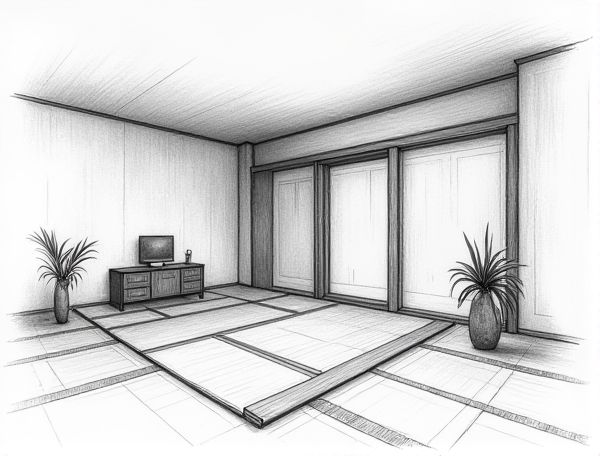
Photo illustration: Japanese-inspired home design with tatami mat flooring
Embrace the serene elegance of Japanese-inspired home design by incorporating tatami mat flooring, which brings natural warmth and a sense of calm to your living space. Discover how this traditional flooring choice can transform Your home into a tranquil retreat--read more in the article.
Introduction to Japanese-Inspired Home Design
Japanese-inspired home design emphasizes minimalism, natural materials, and seamless indoor-outdoor integration, creating tranquil, functional living spaces. Key elements include tatami mat flooring, shoji screens, and a neutral color palette that harmonizes with nature.
The Cultural Significance of Tatami Mat Flooring
Tatami mat flooring embodies centuries of Japanese tradition, symbolizing harmony, simplicity, and natural beauty within home design. Incorporating tatami mats into Your living space enhances cultural authenticity while promoting comfort and a connection to nature.
Key Elements of Japanese Interior Aesthetics
Japanese interior aesthetics emphasize natural materials such as bamboo, wood, and paper to create a harmonious and calming environment. Minimalistic design, sliding shoji screens, tatami mats, and an integration of indoor and outdoor spaces highlight simplicity, functionality, and a deep connection to nature.
Choosing the Right Tatami Mats for Your Space
Selecting the right tatami mats involves considering the size, thickness, and material quality to ensure comfort and durability in your living space. Opt for natural igusa grass mats for authentic texture and better air circulation, enhancing both aesthetic appeal and indoor air quality.
Integrating Shoji Screens and Sliding Doors
Integrating shoji screens and sliding doors enhances natural light diffusion while maintaining privacy in home design. These elements maximize space efficiency by eliminating the need for door swing clearance, ideal for compact or minimalist interiors. The use of traditional rice paper panels combined with modern wood or metal frames adds a blend of cultural elegance and contemporary functionality.
Minimalistic Furniture and Functional Design
Minimalistic furniture emphasizes clean lines and uncluttered spaces, enhancing your home's sense of openness while maintaining practical functionality. Functional design integrates multi-purpose pieces that maximize usability and streamline your living environment for efficient daily living.
Creating a Serene Zen Atmosphere
Incorporate natural elements like bamboo, smooth stones, and indoor plants to establish a serene Zen atmosphere that promotes relaxation and mindfulness. Your home design should emphasize minimalism, soft lighting, and neutral color palettes to foster tranquility and balance throughout the space.
Blending Natural Materials and Neutral Colors
Blending natural materials such as wood, stone, and linen with neutral color palettes including beige, taupe, and soft gray creates a timeless and calming interior that enhances the organic aesthetic and promotes a harmonious living space. Incorporating textures like raw wood grain and natural fibers accentuates warmth and depth while maintaining a minimalist and sustainable design approach.
Maintenance Tips for Tatami Mat Flooring
Regularly vacuum or sweep your tatami mat flooring to prevent dust accumulation and maintain its natural texture. Ensure proper ventilation and avoid direct sunlight exposure to prevent mold growth and fading, protecting your investment's longevity.
Modern Adaptations of Traditional Japanese Design
Modern adaptations of traditional Japanese design emphasize simplicity, natural materials, and seamless indoor-outdoor integration to create tranquil living spaces. You will find tatami-inspired flooring, shoji screens reimagined with contemporary materials, and minimalist furniture that honors traditional craftsmanship while fitting modern aesthetics. These design elements foster harmony and balance, making your home a calming retreat rooted in cultural elegance.
 homedesy.com
homedesy.com